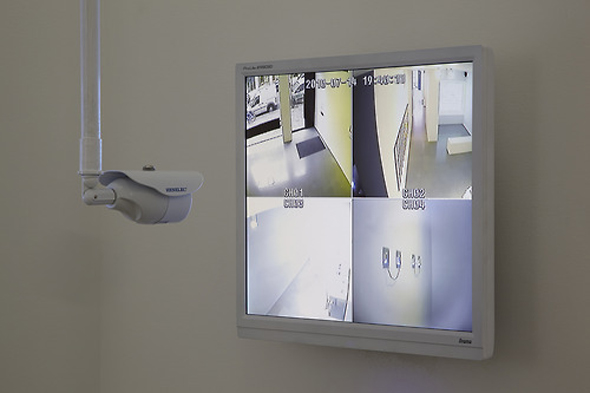
UBERMORGEN was founded in 1995 by the artist duo lizvlx and Hans Bernhard in Vienna, Austria. The duo’s first exhibition at Carroll/Fletcher, userunfriendly, is an excellent opportunity to reflect on conceptual art practices that, since the 1990s, have explored software art, pixel painting, computer installations, net.art and digital activism (media hacking). The exhibition explores the visual languages of digital technologies, their everyday functions, and their relationship to surveillance, human rights, censorship and democracy. The visual world that UBERMORGEN engages brings the media, corporations, governments and violence into a series of critical relationships. These speak to current debates about the meaning of democracy, globalisation and the transmission of information in the twenty-first century. This is a research-rich art practice; and one that thinks about the legacies of twentieth century conceptual art in the present: Dada and Viennese Actionism are important. UBERMORGEN challenges the artwork’s relationship to the political realm, placing it under scrutiny. This is an interesting point of tension within the exhibition as a whole: ‘If art and art production politicizes itself, it becomes political and ceases to be art’ (www.UBERMORGEN.com Manifesto, 2009). “Ubermorgen” is the German word for “the day after tomorrow” and “super-tomorrow“: a fitting name for practices at the cutting-edge of what it means for artists to take on the mediums so intimately related to our everyday lives and our navigation of the world, in the 21st century. Interviews, including one between UBERMORGEN and Edward Snowden, are published in a booklet produced by Carroll/Fletcher for userunfriendly. This is available from the gallery.
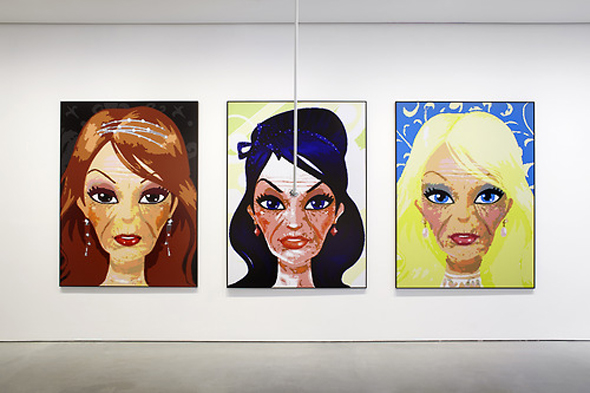 UBERMORGEN – “Oldify™”, (2013). Pigment Prints on Canvas; Courtesy Carroll/Fletcher.
UBERMORGEN – “Oldify™”, (2013). Pigment Prints on Canvas; Courtesy Carroll/Fletcher.
UBERMORGEN is a collaborative project, a Gesamtkunstwerk, which is interesting in itself. What form does the collaboration take?
The most important thing is that we don’t work together! We have completely different views on art. lizvlx is a fantastic painter, very good visually and with the installation of work, how it appears in a space, and so we can do installations. I don’t have training in that way: my work is more about narrative, and conceptual aspects. We bring different things to the process.
Does your collaboration come from a historical place?
We come from the net.art, and the avant-garde movement of the 1990s. It’s significant how many artist duos or collectives were founded then. This was not about hierarchy but about collaboration. There were about 30 people in this avant-garde movement around 1994, when it started. It ended in about 1997. We all have a very tolerant and open relationship with each other as artists.
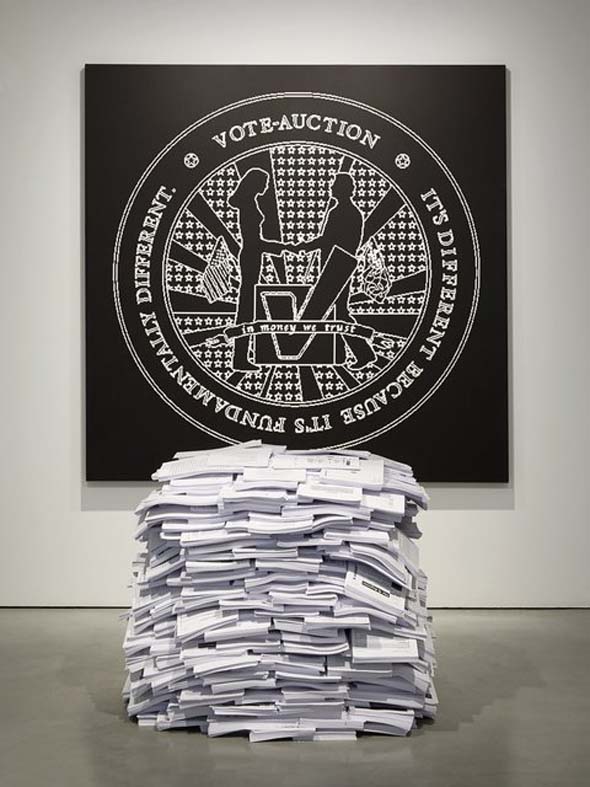 UBERMORGEN – “[V]ote-Auction Seal”, (2000). Pigment Print on Fabric, and “[V]ote-Auction”, 700Kg, (2005). A4 Paper; Courtesy Carroll/Fletcher.
UBERMORGEN – “[V]ote-Auction Seal”, (2000). Pigment Print on Fabric, and “[V]ote-Auction”, 700Kg, (2005). A4 Paper; Courtesy Carroll/Fletcher.
What was the impetus for the installation “[V]ote Auction“?
“[V]ote Auction” is based on a website by an American student who set up a site where you could sell and buy American electoral votes, during the 2000 election (George W. Bush against Al Gore). Due to government intervention, by the FBI and the New York City election committee, the student was forced to get rid of the project. UBERMORGEN bought the project for an undisclosed sum – in a deal brokered by a middleman. This was four months before the election and there were already some articles in the press about it, and some legal procedures.
Viennese Actionism plays an important role in ‘[V]ote Auction’. In fact, in your work as a whole.
Viennese Actionism is important. In a way, we are Eastern Europeans: we have a very morbid sensibility; and there’s a radical-ness to what we do. We used and applied this to “[V]ote Auction“. We really tried to push it to the edge. We decided to pose as Eastern European business people trying to exploit the American electoral market. We asked them to sell us their votes, without the mediation of the middle men, all the advertising consultants, and so on. This all exploded. Here in the exhibition, you can see, for example, a sculpture made up of legal documents: 700 kilograms of documents that were sent to us by American courts in order to stop us. These are injunctions, temporary injunctions.
This is a visual manifestation of legal bureaucracy: legal research, administration, documentary evidence.
Yes. This is the exact scale of the documentation, as we received it. For the display of documentation on the wall we took out one document, an original. It has been signed and stamped by an actual judge. It also shows the actual website, within a legal document, printed out, in an affidavit. Thirteen district attorneys from different states issued temporary injunctions. There was a lot of pressure: The FBI and NSA was researching it. The CIA was involved. The Federal Attorney Janet Reno was investigating the case actively. We called the project online actionism.
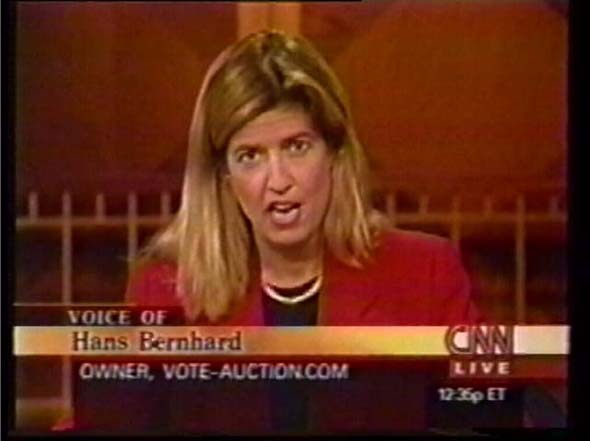 UBERMORGEN – “[V]ote-Auction”, (2000); Courtesy Carroll/Fletcher.
UBERMORGEN – “[V]ote-Auction”, (2000); Courtesy Carroll/Fletcher.
You differentiate between actionism and activism in the way that you work.
Activism is politically motivated which we don’t want to do. This project is not politically motivated. This is an experiment. The body plays a really important role and there is a physicality to what we do. The other part of the project is the media side. We became part of a global mass media storm. Here in the exhibition is a 27 minute feature about the project; called “Burden of Proof“. It’s on CNN and was a primetime video. We’ve shown it here, in full, with the advertisements and everything. This is the tip of the iceberg. Over the campaign of three or four months we had up to forty interviews per day, sometimes parallel, on the phone and on email, feeding this media frenzy. It was looped back to us. The project was all fake, and so we could say anything, and this would loop into the media and then come back to us. I felt like a membrane in a global media storm. It got very physical, felt very physical.
The idea of the body is a very fascinating aspect of your work. There is a real sense in ‘[V]ote Auction’ of the monolith that is the media, the Internet. It’s overwhelming, immersive, and sometimes you don’t know what is real and what isn’t.
We call this media hacking. It’s the intrusion into mass media, with abundantly available, widely proliferated technology: such as email, websites, mobile phones; and a good story. The narrative is a key part of it. You feed a little bit of information into the media and then it starts to replicate. It starts to grow and it starts to come back to you. You can spin it back. You can just turn the information around and shoot it out again into the world. There is no control over what happens next. This installation tries to represent certain aspects of the project. In the end the only way to really get an idea of the project is to actually talk about it.
I was also struck by some of the documents exhibited on the wall at Carroll/Fletcher: the documents that talk to the actual history of vote-buying in America.
Yes, Chicago actually hit us the hardest. They have a history of corrupt elections going back to Capone, and maybe even further. They reacted very directly and tried to shut us down. The important thing in terms of these legal procedures was that we were in Europe, and American law doesn’t apply there. This is one of the most important things about the project. You cannot buy and sell American votes in the US, but it’s not illegal to do the same thing in Europe. The American courts were confused, they thought they could shut us down, and they couldn’t get hold of us. They would have had to shut down the whole Internet. They did shut down some Internet addresses we were using but they couldn’t, ultimately, shut us up.
They must have registered that this was an art project?
No, they didn’t. We always just said we’re Eastern European business people. The problem was the integrity of the electoral process. If too many votes are sold and bought the election could be invalid.
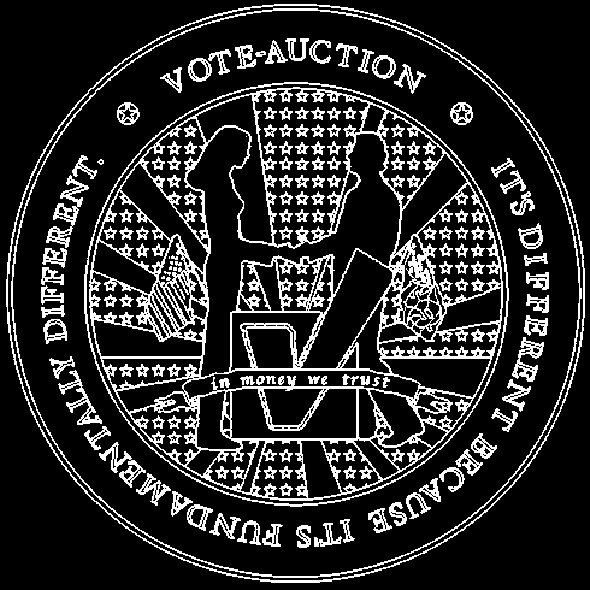 UBERMORGEN – “[V]ote-Auction Seal”, (2000). Pigment Print on Fabric; Courtesy Carroll/Fletcher.
UBERMORGEN – “[V]ote-Auction Seal”, (2000). Pigment Print on Fabric; Courtesy Carroll/Fletcher.
The project asks questions about the nature of democracy. Democracies appear to have all these aspirations: transparency, freedom of speech and so on. They are apparently the opposite of a totalitarian state. But actually what this project unveils is how things like crime, government, money, votes, information, censorship are all so entangled, in democratic processes.
Yes. I should also say something about the artistic nature of the project. We expected that about 500 million people would actually see this project. But the problem was that no one actually realised that this is an art project. What we had to do is transform it using the sculpture, the wall-based work, the video which we then showed in museums and galleries. It was only then that people understood that this is an art project. Before this, no-one knew.
This is also interesting about the way that art enters politics today. You don’t always know where the line is between art and politics. The line gets blurred and this poses questions about the role of art. What is the relationship between art and politics in the 21st century? I think that artists engage with politics in a truly philosophical way. I see a gallery as a potentially important space, intellectually and critically. It’s not simply about commerce. It also produces a space in which to have the time to think about the world and our relation to it, in a way that is critical, contemplative and challenging.
We wrote a manifesto in 2009 and one of the important sentences was: “If art becomes political it ceases to be art“. This is the way we think. This is why we use the term actionism and not activism. Our art is based in experimentation. It’s about trial and error. It is about putting things out there and then seeing what happens. Rather than having a message, a goal or a point that we want to make. We don’t want to make a point and this leads to a lot of confusion. The perception is that it is a very political project. I won’t deny that. But in the production it wasn’t. It was a stunt. It was an action. It was about putting our bodies into the centre of this mass media thing, and then looking and seeing what happens. How do we feel? What do we do? What happens if we put out a story, and it feeds back completely differently? We are interested in experimental stuff rather than making a point.
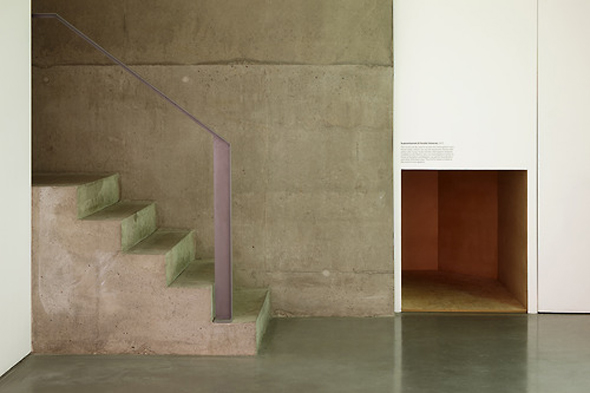 UBERMORGEN – “Superenhanced (A Parallel Universe)”, (2013), Installation comprised of 1 Split-Screen, 2 CCTV Cams, 2 Players, Pre-recorded Performance, Tortureclassics Performance Movie, Lamp, Handcuffs and Chains, Hood, iPad and Casing (excluding Software), 2 Chairs, 2 Steel Hook; Courtesy Carroll/Fletcher.
UBERMORGEN – “Superenhanced (A Parallel Universe)”, (2013), Installation comprised of 1 Split-Screen, 2 CCTV Cams, 2 Players, Pre-recorded Performance, Tortureclassics Performance Movie, Lamp, Handcuffs and Chains, Hood, iPad and Casing (excluding Software), 2 Chairs, 2 Steel Hook; Courtesy Carroll/Fletcher.
The way you differentiate between Actionism and Activism is very interesting.
For me it’s really important. It’s important because we come from Vienna, it’s our tradition, and it’s an Eastern European thing. It’s body-centred and it’s about pushing limits. Otto Muehl, so important to Viennese Actionism, just died: he did things that are awful, that are just not justifiable. I think “[V]ote Auction” maybe is, for a lot of people, not justifiable. We got so many death threats during this project by American veterans who said: ‘My friends died in the Second World War for democracy. You’re fucking it up. I want to kill you’. Actionists had to go into exile because of the actions they did with sex, sperm, blood, shit and stuff like that.
How you work as an artist is so rooted in a geographical place, and in the story of Viennese Actionism.
Perhaps the work we do wouldn’t be possible anywhere else. I am actually Swiss-American but I have lived in Austria for 20 years, and have very much assimilated into the culture. The work “Vladimir“, relates to the Eastern European aspect of my work: What you see here is a CCTV monitor split into 4 screens. One screen shows the actual piece which is downstairs in the gallery. The other one shows Vladimir Putin at a press conference. His press conferences are very interesting, politically. There are also images which speak about how he portrays himself: heroic images of him fishing, or shooting. This work relates to the animated canvas (downstairs).
The canvas is printed on but is also projected on with a GIF animation. GIF animation is similar to a movie; it’s another format for the moving image. The picture is of Putin in Tuva, fishing in 2007. It is a media performance; he shows himself in a certain macho way. In showing this piece we wanted to make the connection to our geographical location, and where we are assimilated and cultivated as artists. It’s especially interesting in relation to England because it is so far away from Russia. If you speak to American people they’re still living in the Cold War in their imaginations. These societies Russia, the Eastern European societies, are very macho. We live in this kind of society and we have to deal with it. This portrayal is not to make fun of Putin but rather to put him on the spot and to think about him as a politician.
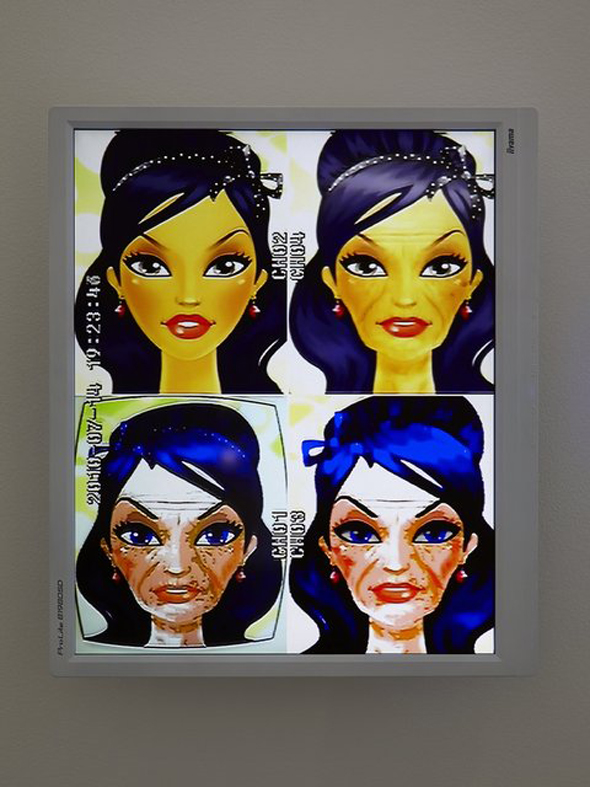 UBERMORGEN – “Oldify™ Laiwa”, (2013), Installation comprised of Pigment Print on Canvas (186 x 140 cm), 1 Split-Screen, 1 CCTV Cam, 3 Media-Players, Animated GIF; Courtesy Carroll/Fletcher.
UBERMORGEN – “Oldify™ Laiwa”, (2013), Installation comprised of Pigment Print on Canvas (186 x 140 cm), 1 Split-Screen, 1 CCTV Cam, 3 Media-Players, Animated GIF; Courtesy Carroll/Fletcher.
Tell me more about what a GIF is? You see it around a lot at the moment.
The GIF is one of, if not the first, image format on the web historically. The GIF is a container, and very early on you were able to put several images into this container, and the web browser could play it as a movie file. You could also loop it and play it over and over again. At the beginning of the Internet this was wonderful because there was so little capacity; it wasn’t possible to show a big movie. But a little GIF gave you the possibility to have a moving image on a website without it taking up a lot of space. Today it has become its own aesthetics, and it has its own art scene. We’ve been working with it for 20 years now. It has become pretty trendy in the last couple of years. For us it’s really nice to have a major painting piece that is projected with a GIF that is 20 kilobytes: this is nothing, it’s like 1 frame of a movie.
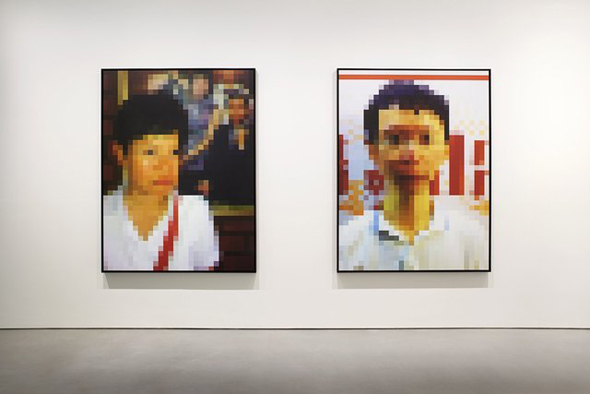 UBERMORGEN – “Singapore Psychos, (Lishan, Akmal)”, (2013). Pigment prints on canvas; Courtesy Carroll/Fletcher.
UBERMORGEN – “Singapore Psychos, (Lishan, Akmal)”, (2013). Pigment prints on canvas; Courtesy Carroll/Fletcher.
The paintings are interesting from the point of view of their relationship to technology: playing with grids, pixels, GIF technology and so forth.
The grid paintings, the pixelated paintings relate to a style we have used for 15 years. These paintings – downstairs in the gallery – are part of the Icon series. We portray iconic figures of the 20th and 21st century (Vladimir Putin is one of these). In an interview with an Austrian physicist, Dr. Tobias Noebauer, we talk about whether the pixel is the smallest part in the visual universe as opposed to sub-atomic particles in the physical universe. We haven’t resolved this yet. We usually take thumbnail pictures; or we reduce images to a thumbnail, to a really small size, and then we blow them up again, and then have 60 by 40 pixels (for example). This is about the amount of information that you get in the regular mass media or in a tweet or something like that.
If you look at the media landscape we are overwhelmed with information. The information gets less and less because it has to be in these tiny bits, twitter feeds, SMS/texting is also responsible for this. A lot of people are critical of this but I am interested in the possibilities of the relationship between technology and the brain, and how particular ways of using the brain might facilitate connections and processes of completing information. We can use bits of information, expand them in our brain, connect them and that’s amazing.
The paintings are the work of lizvlx?
Yes, Liz is a trained painter. I don’t see a big difference between a painter who uses a brush and a painter who uses the computer. As a painter, working in oils or acrylics, you have to know your material, and it’s the same with a computer, it’s material in the end. You have to know how the material behaves, how the software behaves in order to get what you want. Or you can use accidents or specific aspects of the software to explore things that you can do with oil or acrylic too, things like layering. She actually paints the pictures using technology. We take the raw material, we take the photos and then we work them over with an algorithm or reduce them. Then Liz paints them. It can take days or weeks for one painting. She selects every individual pixel, and selects the colour. We both come from digital and net.art, and so we don’t think about whether or not these are paintings. But the moment you are in a museum or gallery the curators ask about why we call these paintings. There is a dialogue that takes place.
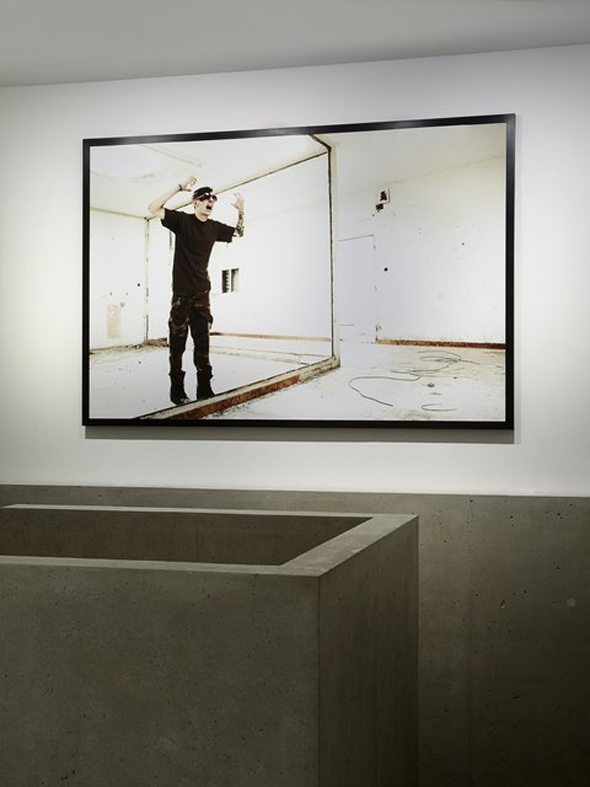 UBERMORGEN – “Perpetrator I”, (2008). Pigment Print on Paper; Courtesy Carroll/Fletcher
UBERMORGEN – “Perpetrator I”, (2008). Pigment Print on Paper; Courtesy Carroll/Fletcher
It’s quite claustrophobic, the knowledge that there are quite literally cameras recording us, and transmitting images of us to other parts of the gallery. You also look at interrogation and torture, bringing it into a relationship with surveillance.
The show is called userunfriendly and I think technology should be like that. The “Superenhanced” Project is based on research that took 3 years. We were looking at torture. After 3 years of research we had amazing amounts of material. We spoke to people such as detainees, and prison guards. We came up, in the end, with interrogation software. In the gallery, in the stairwell, we’ve constructed a tunnel that goes down like a dungeon, to a cell. To enter the cell you have to crawl through the tunnel. Through the tunnel there’s an interrogation chamber with a black hood, cuffs and software. The software tells me what to ask you, and if you answer right we will proceed, and if you don’t you will be punished and tortured. This takes away the responsibility from the actual person to the machine. It questions the chain of command and the outsourcing of responsibility. From upstairs, in the gallery, you look at the photograph of a Guantanamo Bay prison guard and down into the cell-like space. The perpetrator has a name, has a face, and looks down onto the nameless, faceless victim. This prison guard lived in our house in Vienna for 2 months, we picked his brain and we talked with him. He tortured people, brought people to places where they were tortured, he filmed torture, and watched it. We facilitated the photograph, the location (an old train station in Vienna), and the photographer but had nothing to do with how it was shot, we were not present. I didn’t want to produce or direct it. There are a series of these pictures.
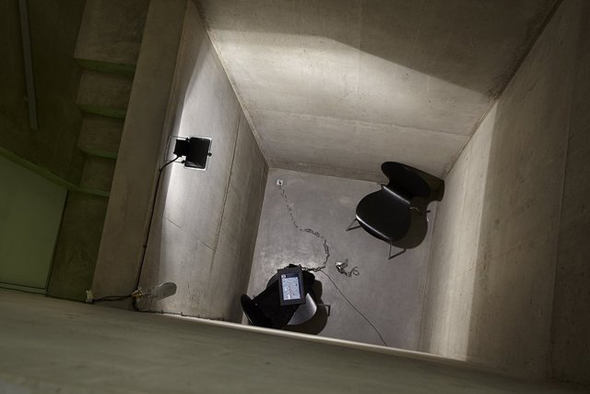 UBERMORGEN – “Superenhanced (A Parallel Universe)”, (2013), Installation comprised of 1 Split-Screen, 2 CCTV Cams, 2 Players, Pre-recorded Performance, Tortureclassics Performance Movie, Lamp, Handcuffs and Chains, Hood, iPad and Casing (excluding Software), 2 Chairs, 2 Steel Hook; Courtesy Carroll/Fletcher.
UBERMORGEN – “Superenhanced (A Parallel Universe)”, (2013), Installation comprised of 1 Split-Screen, 2 CCTV Cams, 2 Players, Pre-recorded Performance, Tortureclassics Performance Movie, Lamp, Handcuffs and Chains, Hood, iPad and Casing (excluding Software), 2 Chairs, 2 Steel Hook; Courtesy Carroll/Fletcher.
The references to Internet and computer technologies is such an important aspect of this exhibition and how it is curated. I am thinking here about the section curated by the German artist Aram Bartholl.
These are routers: they connect your laptop, phone or wireless to the Internet. They are hooked up to the Internet, and send and receive data over the air. These five routers were hacked and a server was put on each, changing their function. They stopped being routers and became servers, with Wi-Fi capability. Each of the routers holds one of the UBERMORGEN net.art projects from 1990 to 2010. This technology was invented by Aram Bartholl, who curates this section of userunfriendly. It’s the first time that we have a way of showing net.art in a gallery, museum or somewhere like the home of a collector, without using a screen. It’s designed to be consumed on your personal computer but you don’t have to be at home, you can also use your phone. People can select one of these five networks that are open here, go on the browser, and see only this artwork on this network. They have to change to another network to see others. The actual object is a website and there is an edition of 1+1: You can buy this object, with the content, with the software, and there is one copy that is online that is like the Artists Proof (this will stay online). We thought recently of it as a vitrine, a website is like a three dimensional object.
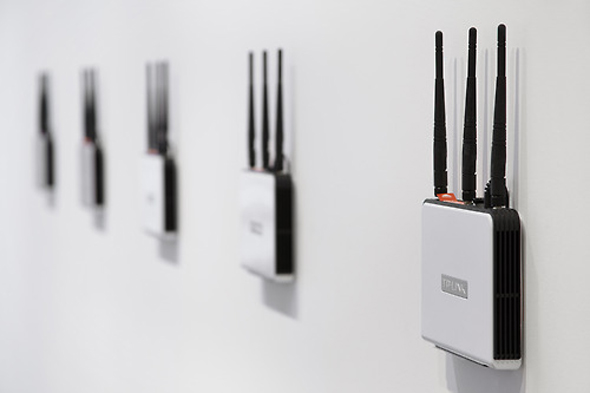 UBERMORGEN & Aram Bartholl – “Net.Art”, (1999-2010); Courtesy Carroll/Fletcher.
UBERMORGEN & Aram Bartholl – “Net.Art”, (1999-2010); Courtesy Carroll/Fletcher.
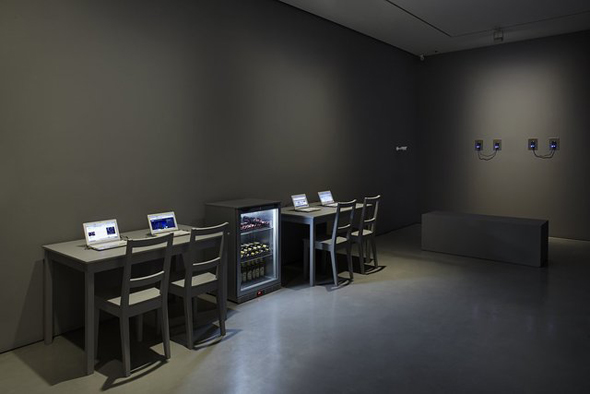 UBERMORGEN – “Do You Think That’s Funny?”, (2013), Installation comprised of 4 Beagle Bones, Snowden Files (encrypted), Glass front Fridge, Club Mate, 4 Tables, 4 Chairs, 4 Netbooks, Ethernet Cables, Amnesia OS, Manuals, 1 Split-Screen, 4 CCTV Cameras, 4 USB Flash Drives; Courtesy Carroll/Fletcher.
UBERMORGEN – “Do You Think That’s Funny?”, (2013), Installation comprised of 4 Beagle Bones, Snowden Files (encrypted), Glass front Fridge, Club Mate, 4 Tables, 4 Chairs, 4 Netbooks, Ethernet Cables, Amnesia OS, Manuals, 1 Split-Screen, 4 CCTV Cameras, 4 USB Flash Drives; Courtesy Carroll/Fletcher.
___________________________________________________________________________________
Additional Information
CAROLL/FLETCHER
“Userunfriendly” – UBERMORGEN
Exhibition until Nov. 16, 2013.
Opening Hours: Mon-Fri (11am-7pm); Sat (11-6pm)
56 – 57 Eastcastle Street, London (click here for map)
Article by Yvette Greslé with Hans Bernhard, at Carroll/Fletcher in London; Sunday, Oct. 27, 2013. Originally posted on FAD
___________________________________________________________________________________
FAD is a multi-media, on-line platform offering an eclectic mix of cool happening art stuff. FAD cover contemporary art news and all forms of creativity to do with urban life. Video and performance art, photography, street art, design and anything at the cutting-edge of 21st century culture.




















